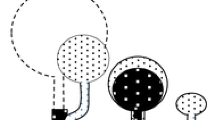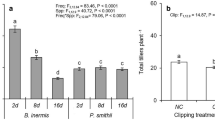Abstract
Clonal architecture may enable plants to effectively respond to environmental constraints but its role in plant tolerance to defoliation remains poorly documented. In several non-clonal species, modifications of plant architecture have been reported as a mechanism of plant tolerance to defoliation, yet this has been little studied in clonal plants. In a glasshouse experiment, five rhizomatous and five stoloniferous species of grazed pastures were subjected to three frequencies of defoliation in order to test two hypotheses. (1) We expected plant clonal response to defoliation to be either a more compact architecture (low clonal propagation, but high branching), or a more dispersed one (long-distance propagation and low branching). Such plastic adjustments of clonal architecture were assumed to be involved in tolerance to defoliation i.e. to promote genet performance in terms of biomass and number of ramets. (2) The response of clonal architecture to defoliation was expected to be dependent on the species and to be more plastic in stoloniferous than in rhizomatous species. Most genets of each species were tolerant to defoliation as they survived and developed in every treatment. Architectural modifications in response to defoliation did not match our predictions. Clonal growth was either maintained or reduced under defoliation. Relative growth rate (RGR) decreased in eight species, whereas defoliated genets of seven species produced as many ramets as control genets. Biomass allocation to ramet shoots remained stable for all but one species. In defoliated genets, the number and mean length of connections, and mean inter-ramet distance were equal to or lower than those in control genets. Four groups of species were distinguished according to their architectural response to defoliation and did not depend on the type of connections. We hypothesised that dense clonal architectures with low plasticity may be the most advantageous response in defoliated conditions such as in grazed pastures.




Similar content being viewed by others
References
Belsky AJ (1986) Does herbivory benefit plants? A review of the evidence. Am Nat 127:870–892. doi:10.1086/284531
Briske DD (1996) Strategies of plant survival in grazed systems: a functional interpretation. In: Hodgson J, Illius AW (eds) The ecology and management of grazing systems. CAB International, Wallingford, pp 37–67
Brown B, Allen T (1989) The importance of scale in evaluating herbivory impacts. Oikos 54:189–194. doi:10.2307/3565265
de Kroon H, Schieving F (1990) Resource partitioning in relation to clonal growth strategy. In: van Groenendael J, de Kroon H (eds) Clonal growth in plants: regulation and function. SPB Academic Publishing, The Hague, pp 113–130
Del-Val E, Crawley MJ (2005) Are grazing increaser species better tolerators than decreasers? An experimental assessment of defoliation tolerance in eight British grassland species. J Ecol 93:1005–1016. doi:10.1111/j.1365-2745.2005.01011.x
Dolédec S, Chessel D (1991) Recent development in linear ordination methods for environmental sciences. Adv Ecol 1:133–155
Dong M, de Kroon H (1994) Plasticity in morphology and biomass allocation in Cynodon dactylon, a grass species forming stolons and rhizomes. Oikos 70:99–106. doi:10.2307/3545704
Dong M, Pierdominici MJ (1995) Morphology and growth of stolons and rhizomes in three clonal grasses, as affected by different light supply. Vegetatio 116:25–32
Gardner SN, Mangel M (1997) When can a clonal organism escape senescence? Am Nat 150:462–490. doi:10.1086/286076
Gross N, Suding KN, Lavorel S (2007) Leaf dry matter content and lateral spread predict response to land use change for six subalpine grassland species. J Veg Sci 18:289–300. doi:10.1658/1100-9233(2007)18[289:LDMCAL]2.0.CO;2
Hay MJM, Newton PCD (1996) Effect of severity of defoliation on the viability of reproductive and vegetative axillary buds of Trifolium repens L. Ann Bot (Lond) 78:117–123. doi:10.1006/anbo.1996.0103
Hicks S, Turkington R (2000) Compensatory growth of three herbaceous perennial species: the effect of clipping and nutrient availability. Can J Bot 78:759–767. doi:10.1139/cjb-78-6-759
Huber H, During HJ (2001) No long-term costs of meristem allocation to flowering in stoloniferous Trifolium species. Evol Ecol 14:731–748. doi:10.1023/A:1011643904616
Huber H, Lukacs S, Watson MA (1999) Spatial structure of stoloniferous herbs: an interplay between structural blue-print, ontogeny and phenotypic plasticity. Plant Ecol 141:107–115. doi:10.1023/A:1009861521047
Hutchings MJ (1999) Clonal plants as cooperative systems: benefits in heterogeneous environments. Plant Species Biol 14:1–10. doi:10.1046/j.1442-1984.1999.00001.x
Hutchings MJ, Bradbury IK (1986) Ecological perspectives on clonal perennial herbs. Bioscience 36:178–182. doi:10.2307/1310305
Hutchings MJ, Wijesinghe D (1997) Patchy habitats, division of labour and growth dividends in clonal plants. Trends Ecol Evol 12:390–394. doi:10.1016/S0169-5347(97)87382-X
Jiaseński M, Bazzaz FA (1999) The fallacy of ratios and the testability of models in biology. Oikos 84:321–326. doi:10.2307/3546729
Kleijn D, van Groenendael J (1999) The exploitation of heterogeneity by a clonal plant in habitats with contrasting productivity levels. J Ecol 87:873–884. doi:10.1046/j.1365-2745.1999.00406.x
Klimeš L, Klimešovà J (1999) CLO-PLA2—a database of clonal plants in central Europe. Plant Ecol 141:9–19. doi:10.1023/A:1009801216504
Klimeš L, Klimešovà J, Hendricks R, van Groenendael J (1997) Clonal plant architecture: a comparative analysis of form and function. In: de Kroon H, van Groenendael J (eds) The ecology and evolution of clonal plants. Backhuys Publishers, Leiden, pp 1–29
Legendre P, Legendre L (1998) Numerical ecology, 2nd English edn. Elsevier Scientific Publishing Company, Amsterdam
Lennartsson T, Nilsson P, Tuomi J (1998) Induction of overcompensation in the field gentian, Gentianella campestris. Ecology 79:1061–1072
Li B, Shibuya T, Yogo Y, Hara T (2004) Effect of ramet clipping and nutrient availability on growth and biomass allocation of yellow nutsedge. Ecol Res 19:603–612. doi:10.1111/j.1440-1703.2004.00685.x
Liao M, Yu F, Song M, Zhang S, Zhang J, Dong M (2003) Plasticity in R/S ratio, morphology and fitness-related traits in response to reciprocal patchiness of light and nutrients in the stoloniferous herb, Glechoma longituba L. Acta Oecol 24:231–239. doi:10.1016/j.actao.2003.07.001
Loucougaray G, Bonis A, Bouzillé JB (2004) Effect of grazing by horses and/or cattle on the diversity of coastal grasslands in western France. Biol Conserv 116:59–71. doi:10.1016/S0006-3207(03)00177-0
MacDonald SE, Lieffers VJ (1993) Rhizome plasticity and clonal foraging of Calamagrostis canadensis in response to habitat heterogeneity. J Ecol 81:769–776. doi:10.2307/2261674
Macek P, Lepš J (2003) The effect of environmental heterogeneity on clonal behaviour of Prunella vulgaris L. Plant Ecol 168:31–43. doi:10.1023/A:1024460525317
Maschinski J, Whitham TG (1989) The continuum of plant responses to herbivory: the influence of plant association, nutrient availability, and timing. Am Nat 134:1–19. doi:10.1086/284962
McNaughton SJ, Chapin FSIII (1985) Effects of phosphorus nutrition and defoliation on C4 graminoids from the Serengeti plains. Ecology 66:1617–1629. doi:10.2307/1938024
Moen J, Ingvarsson PK, Walton DWH (1999) Estimates of structural complexity in clonal plant morphology: comparison of grazed and ungrazed Acaena magellanica rhizomes. Can J Bot 77:869–876. doi:10.1139/cjb-77-6-869
Oborny B, Kun A (2002) Fragmentation of clones: how does it influence dispersal and competitive ability? Evol Ecol 15:319–346. doi:10.1023/A:1016084815108
Owen D (1980) How plants may benefit from the animals that eat them. Oikos 35:230–235. doi:10.2307/3544430
Paige KN, Whitham TG (1987) Overcompensation in response to mammalian herbivory: the advantage of being eaten. Am Nat 129:407–416. doi:10.1086/284645
Piqueras J (1999) Herbivory and ramet performance in the clonal herb Trientalis europara L. J Ecol 87:450–460. doi:10.1046/j.1365-2745.1999.00372.x
Price EAC, Marshall C (1999) Clonal plants and environmental heterogeneity. An introduction to the proceedings. Plant Ecol 141:3–7. doi:10.1023/A:1009838300691
Richards JH, Mueller RJ, Mott MT (1988) Tillering in tussock grasses in relation to defoliation and apical bud removal. Ann Bot (Lond) 62:173–179
Stowe KA, Marquis RJ, Hochwender CG, Simms EL (2000) The evolutionary ecology of tolerance to consumer damage. Annu Rev Ecol Syst 31:565–595. doi:10.1146/annurev.ecolsys.31.1.565
Strauss SY, Agrawal AA (1999) The ecology and evolution of plant tolerance to herbivory. Trends Ecol Evol 14:179–185. doi:10.1016/S0169-5347(98)01576-6
Stuefer JF, Huber H (1998) Differential effects of light quantity and spectral light quality on growth, morphology and development of two stoloniferous Potentilla species. Oecologia 117:1–8. doi:10.1007/s004420050624
Suzuki JI, Stuefer JF (1999) On the ecological and evolutionary significance of storage in clonal plants. Plant Species Biol 14:11–17. doi:10.1046/j.1442-1984.1999.00002.x
Thioulouse J, Chessel D, Dodélec S, Olivier JM (1997) ADE-4: a multivariate analysis and graphical display software. Stat Comput 7:75–83. doi:10.1023/A:1018513530268
Wang Z, Li L, Han X, Dong M (2004) Do rhizome severing and shoot defoliation affect clonal growth of Leymus chinensis at ramet population level? Acta Oecol 26:255–260. doi:10.1016/j.actao.2004.08.007
Acknowledgements
We thank Véronique Sauzière, Christine Tyrant, Thierry Fontaine and Fouad Nassur for their technical support to carry out this experiment. This manuscript is part of the ACI-ECCO ECOGER ‘DIVHERB’ program and of the GDR CNRS 2574 ‘TRAITS’.
Author information
Authors and Affiliations
Corresponding author
Electronic supplementary material
Rights and permissions
About this article
Cite this article
Benot, ML., Mony, C., Puijalon, S. et al. Responses of clonal architecture to experimental defoliation: a comparative study between ten grassland species. Plant Ecol 201, 621–630 (2009). https://doi.org/10.1007/s11258-008-9546-3
Received:
Accepted:
Published:
Issue Date:
DOI: https://doi.org/10.1007/s11258-008-9546-3




